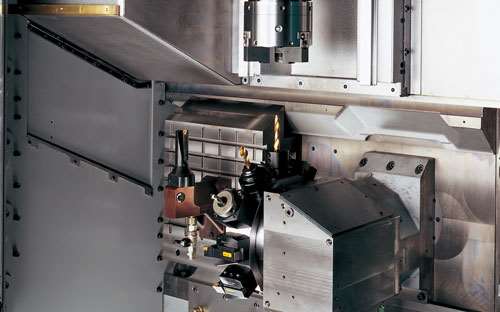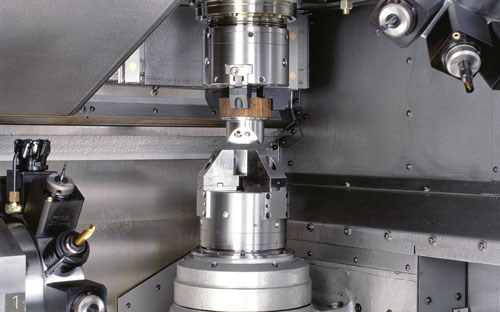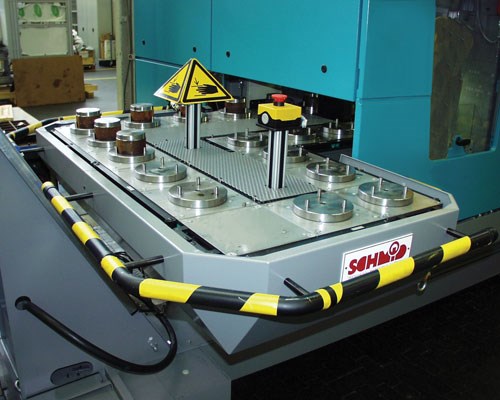The Upside of Vertical Turning
Vertical turning centers that use the main spindle to load and unload themselves are finding increasing acceptance as multitasking capabilities make them efficient processing centers for producing chucked parts.
#basics #horizontal-and-vertical-lathes
For more than a century, vertical turning lathes (VTL) conjured up brands like G.A. Gray, Bullard and Giddings and Lewis. These were big machines for big workpieces designed to handle chucked parts that are simply too heavy for a horizontal configuration.
Then, back in the early 1980s, a clever engineer came up with the idea of flipping the traditional VTL 180 degrees, placing the main spindle on the way system that carried the turret and cutting tools and placing the cutting tools on the base where the spindle had traditionally resided. Whether it is called inverted spindle or pick-up spindle, this class of vertical turning center is aimed at providing low-cost, highly flexible series production of chucking parts and offers production turning shops some unique advantages.
Featured Content
Those early inverted vertical machines were basically horizontal turning centers configured in a vertical orientation. Over time, like most classes of machine tools, the inverted vertical lathe has evolved, adding numerous machining capabilities for multitasking that the earlier machines did not have.
For this article, we took a look at how this technology has evolved by talking to Index Corp. and using its V160 model as an example of advanced current inverted vertical turning capabilities. It is representative of the current level of technology available in the inverted vertical class of machine tools.
Take a Load Off
Harkening back to its VTL origins, inverted verticals are built around a portal design; just scaled down for the workpiece diameters it is designed to process. The nominal chuck size on the V160 is 160 mm (6.5 inches) or 200 mm (8 inches), a far cry from blanks measured in meters/feet that traditional VTL are designed to handle.
Placing the main spindle on the X-axis bridge that connects the support uprights creates a box-frame structure that is rigid regardless of the spindle’s X-axis travel extremes. The spindle carrier is fully supported over its full travel.
Generically, the inverted vertical machine design lends itself very well to auto-loading in a variety of ways. The vertical motor spindle carries out the “handling” and “machining” functions.
The self-loading inverted spindle concept eliminates the need for added automation systems since the moving spindle does double duty as an integral gantry loader. Short travel distances, combined with high rapid traverse speeds, substantially reduce nonproductive time.
The X-axis stroke allows the main spindle to travel outside the machine’s workzone to “pick up” a part blank from a single or multiple conveyor system located outside the cutting area. The work area is easily accessible allowing for the use of multiple types of conveyor systems. The open front of this compact machine gives accessibility for operator convenience and for quick setup and change-over.
The V160 uses linear drives in the X axis, which is the usual handling axis on inverted verticals. Linear motors achieve dynamics, speed and short handling times that expedite the load/unload function of the machine. The maximum rapid traverse rate of the relatively long X axis is 80 m/min, or 3,150 ipm, and the acceleration rate is 1g.
Open to New Ideas
The portal design of the inverted vertical machine creates an open work zone, which provides more possibilities for multitask machining. It also uses gravity for simple, effective chip evacuation.
In the case of the V160 turning center configuration, as many as four turrets are available with as many as 48 tool stations using VDI quick change presettable tools can either be fixed or live tools. Two tool carriers can be configured with an optional Y and B axis. And there are other ways to configure this class of machine tool that can expand its production capability well beyond turning.
Overall, the open front design concept significantly reduces setup time, and results in lower production cost, especially on small to medium lot sizes. Whether it is a compact version, with one spindle and up to two tool carriers, and an auxiliary tool clamping plate, or a version with main and counterspindles and as many as four tool carriers, productivity is a key characteristic. Index and other builders use a building-block system in which various modules can be integrated within the workzone for added flexibility by permitting automation and other accessories to be custom configured for a process-oriented, application-optimized solution.
As it has developed since the 1980s, the inverted vertical has evolved toward becoming a versatile and capable metalworking center. In-process as well as post process gaging can easily be added with minimal investment. Using the spindle as a gantry loader enables inspection to be integrated into the process. On the V160, Y/B axis is available, which permits angular and off-center drilling, milling and gaging.
The relatively large open work area makes it possible to integrate special machining units, such as internal or external grinding spindles, high power multi-spindle drill heads, polygon turning units, or high frequency drill and mill spindles, as well as large milling heads. All of those are in addition to the standard VDI live tools in the turret.
One such module, available on the V160, is the addition of a counterspindle. Two identically built motorized spindles, capable of speeds to 5,000 rpm, provide power of 20 kW and precision in the roundness range of 3 micrometers and can provide 1-micrometer roundness if needed. The secondary or counterspindle module can be used for internal part transfer from main to counterspindle. The move requires no machine related axis alignment at the part transfer position.
On the counterspindle version, the two X axes are perpendicular to each other and intersect at the workpiece transfer point. For the backworking operation, the workpiece can be transferred with minimum loss of chucking precision to the counterspindle for machining of the opposed end. This ensures highest concentricities from one side to the other. The point of transfer is programmable to within microns and provides the ability for op 10 and op 20 to be processed in a single workzone.
For small to medium and even large batch sizes, the vertical turning machine is highly productive because of simultaneous machining with two tools. The proven concept also provides process reliability, reduced setup times, excellent accessibility and large tool capacities in one or more turrets. When glass scales are applied, diameter tolerances to 0.003 mm are achievable.
For higher volume, continuous production, the inverted vertical machine concept lends itself to linking together several machines into a production line, cell or system simply by extending the workpiece conveyor.
Got Grinding?
The ability to process hardened workpieces is a distinct advantage for a production machine. There is no interruption of the workflow if hardened blanks can be run through production using hard turning and, if needed, grinding, to reach final size and surface finish tolerances.
Index’s V160 inverted vertical can be configured to perform rough machining (hard turning) and incorporates ID/OD grinding with auto loading, automatic in-machine wheel dressing and in-process gaging, permitting production of high precision parts complete in a single chucking. This highly efficient and affordable system is capable of performing inverted vertical OD and ID grinding and turning on one platform, saving users throughput time and capital cost while improving cycle times and precision for a range of parts.
For OD grinding, the grinding spindle accepts grinding wheels up to 400-mm/16-inch diameter. It is driven by a programmable intercooled motor spindle with up to 6,000 rpm speed capability and maximum power of 15 kW/22 hp.
Also included is an adjustable angular motor mount and automatic integrated balancing system. Dressing of the wheel does not require a separate CNC wheel dresser, but is accomplished by a dressing tool mounted to the main spindle.
For ID grinding, various types of high precision ID grinding spindles are available with speeds as high as 105,000 rpm. Dressing of the wheels (mostly CBN) is accomplished in a similar fashion as the OD wheel, using a dressing ring mounted to the main spindle as well.
The machine makes sense for applications where highest precision is essential, such as for the machining of components for diesel injection technology, nozzle bodies, HSK tool interfaces, hydraulic components requiring high-quality surface finish and wherever serrations have to be ground.
Other operations that can be performed using the inverted vertical base with various machining modules include deep-hole drilling, eccentric machining and polygon turning. For a system linking together several machines into a production line, many different setup configurations are possible, depending on the style of automation, the operation sequence, and volume required for a particular workpiece or family of parts.
Lights-Out Production
Metalworking shops of all types are dealing with the acute shortage of skilled workers. Automation is one direction many shops are looking to in order to compensate for this shortage.
As the inverted vertical concept has evolved, multiple metalworking capabilities at its core is the fundamental leap forward on a self loading/unloading machine tool. These machines do this without the need for external material handling equipment. It’s built-in automation that comes with the machine’s design.
Using a relatively simple conveyor system to deliver blanks and remove complete parts, the system is ripe for unattended or lightly attended machining. Capacity is set by the conveyor system, which is expandable.
Freeing up the skilled workers tending machines is a key goal for many shops. The inverted vertical machine concept can be made as simple or complex as a shop’s application demands, but regardless of the complexity of the configuration its inherent productivity advantages come at no extra charge.
Because of the modular design and optional capabilities, the configuration of an inverted vertical turning machine to suit your production strategy is almost unlimited.
RELATED CONTENT
-
The Evolution of the Y Axis on Turn-Mill Machines
Introduced to the turn-mill machine tool design in about 1996, the Y axis was first used on a single-spindle, mill-turn lathe with a subspindle. The idea of a Y axis on a CNC originated from the quality limitation of polar interpolation and the difficulty in programming, not from electronic advances in controls or servomotor technology as one might commonly think.
-
VIDEOS: Tips for Screw Making on Swiss-Type Machines
Here’s a three-part video series focused on Swiss screw making to help explain the benefits of thread whirling, back turning and broaching while taking into consideration CAM programming, tooling and machine specifications.
-
Dry Swiss Machining in Medical
Continuing to build its reputation for creative solutions, this multi-faceted medical device component manufacturer took its Swiss machining operations to a new level to meet a customer’s market demands.











.jpg;maxWidth=970;quality=90)